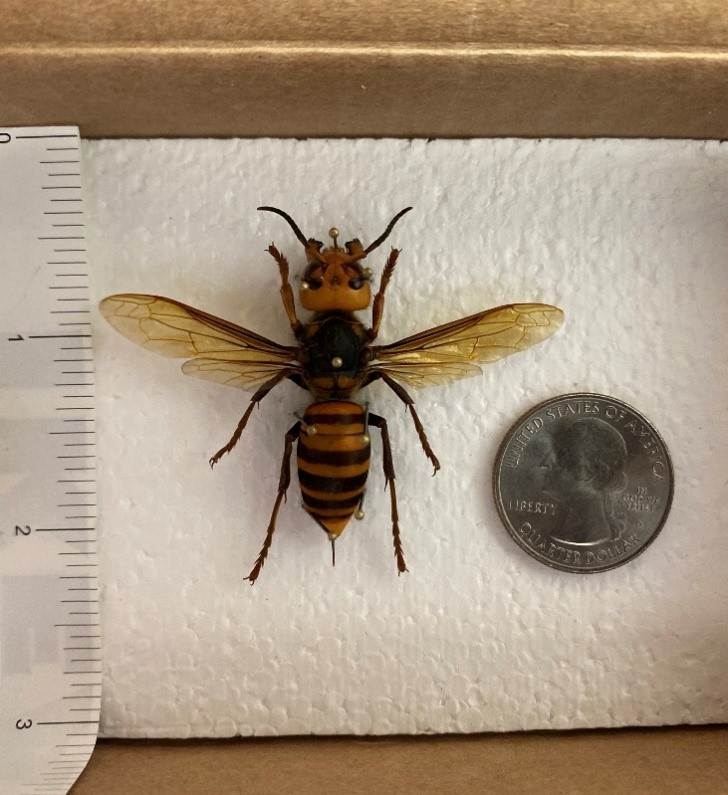Asian Giant/Murder Hornets (Vespa mandarinia) Information and Resources
View the below resources for information on sightings and control of Asian Giant Hornets (ASG), otherwise known as “Murder Hornets”.
USDA New Pest Response Guidelines – Vespa Mandarinia – Asian Giant Hornet
Ontario Agriculture Food and Rural Affairs Public Information on the Asian Giant Hornet
If you see a suspected Asian giant hornet, you can call the Agricultural Information Contact Centre (AICC) at 1-877-424-1300 / ag.info.omafra@ontario.ca to report it (further details below).

What we know:
- At present Vespa mandarina have not been detected in Ontario. The only detections in North America have been in B.C. and Washington State.
- If mandarinia gets a toe-hold in North America it could be very difficult (or impossible to eradicate).
- It is thought that it will have an impact on honey bee populations in North America. But the degree is not known.
- It may do quite well in many parts of the North America – south of B.C. We don’t know how hardy it will be for other areas with a more typical Canadian winter.
- It is not thought to spread by honey bee colonies – but rather equipment or transportation – trucks and freight.
- It can be a hazard for humans, companion animals and livestock. The nests are in the ground where people or animals may walk past.
- It may be difficult to detect any successfully overwintered hornet queens as the colonies get larger throughout the season there are more and more individuals in a colony – and more opportunity to encounter individuals from the colony.
- In Ontario therewere numerous reports last year and this year of the Asian giant hornet from the general public. These were confirmed to be Vespa crabro – (the European Hornet) a large introduced wasp from Europe.
- Vespa crabro has been present in Ontario for over a hundred years. This species is large (2.5 to 3.5 cm, smaller than the AGH) but is not known to be a serious hazard of honey bees and people.
- If you see a suspected Asian giant hornet, you can call the Agricultural Information Contact Centre (AICC) at 1-877-424-1300 to report it. If you have a photograph of a physical specimen you believe to be an Asian giant hornet, you can send the digital photo to the AICC at info.omafra@ontario.ca along with your location and postal code. For photographs, a clear image is needed of the specimen for species confirmation. To help with identification purposes, follow the tips below for submitting photographs:
-
-
- ensure all images are in colour and in focus
- provide images of the following views:
- the back surface of the insect
- the side of the insect
-
- None of the reports have been the Asian giant hornet (most have been crabro, and some have been non-hornets e.g. cicacada killer, ichneumonid wasp).
Further Details on the Asian Giant Hornets:
The information below is a summary Information from B.C.
- Vespa soror – May 2019 – Vancouver harbor. Originally identified as Vespa ducalis but later assessment revised and concluded to be Vespa soro. Specimen was submitted and preserved at the Beaty Biodiversity Research Centre at UBC, and it was concluded to be a queen. No other reports of hornets were received since May and is assumed to be a single introduction.
- Vespa basalis – July 2019 – Richmond. Report was a photo, not verified with actual specimen.
- Vespa mandarinia – August 2019 – Nanaimo. Two independent sightings. A single nest was found and destroyed. Believe that the nest was eradicated prior to the emergence of queens, but recognize the possibility that some may have dispersed. Hence, plans are made to monitor next spring/summer.
- Vespa mandarinia – November 2019 – White Rock. Hornets are currently in winter mode and only mated queens are wintering on their own (same as your standard Yellow jacket and Bald-Faced Hornet). Their presence will not be apparent until emergence sometime in the spring.
How, why and by whom these hornets are brought to Coastal BC remains unknown. BC is currently developing a comprehensive monitoring program for 2020 with various agencies and organizations including local government and beekeeper associations.
BC Monitoring program currently being developed, includes:
- Feeding station(s) with bait set up at locations where hornets have been sighted.
- Feeding stations must be manned to catch any visiting ASG.
- Locating nests will be done through two methods;
- ASG will be cooled and a ‘streamer’ ribbon will be applied. ASG will be released and will be followed for indication of nest direction. New feeding station will be set up and process repeated.
- Captured ASG will be cooled and equipped with a radio tag. After release, receiver will be employed to locate the tagged hornet and search for the nest location.
- Nest eradication will take place through application of CO2 followed by placing specimen into container with iso-propyl alcohol.
- Implementation of this monitoring program involves the public submitting images of hornets or actual specimens, with detailed description of location(s).
- Local beekeepers are also requested to monitoring their colonies closely for hornet visits.

